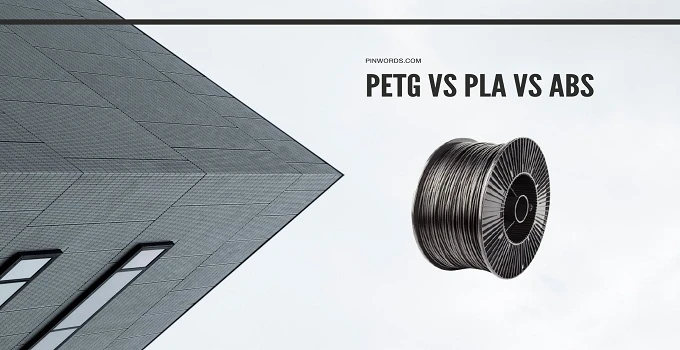3D printing involves the usage of a variety of filaments. The characteristics of these filaments differ from one another, which makes them suitable for printing any object having a defined characteristic.
Let's say you want to repair your R/C car, but you don't want to spend dollars on purchasing expensive gears.
Instead, you prefer making use of your 3D printer to print those parts, so the first thing you would want to look at is the sturdiness of the filament you will be using. Since PLA is sturdy, it makes an ideal filament for printing gears.
Apart from PLA, there are other filaments that are commonly used around the world. In this guide, we will discuss three of the most popular filaments, PETG VS PLA VS ABS.
Contents
| PETG | PLA | ABS | |
|---|---|---|---|
| Ultimate Tensile Strength (MPa) | 46 | 57 | 44 |
| Tensile Modulus (MPa) | 1675 | 2900 | 1940 |
| Tensile Elongation at Failure (%): | 25 | 8 | 10.5 |
| Density (g/cc) | 1.25 | 1.25 | 1.05 |
| Maximum Service Temperature (°C) | 80 | 54 | 105 |

ABS or Acrylonitrile Butadiene Styrene is a popular plastic known for its high durability and longevity. Because of such properties, ABS is used to create LEGO blocks, automotive parts, action figures, and other objects.
ABS is the kind of thermoplastic that becomes moldable when heated, and it hardens when cooled. Since the material is petroleum-based, you can smell an unpleasant odor during the printing process. It also has a high resistance to heat up to 250 degrees Celsius.
When printing with ABS, it is recommended to use a heated bed because the bottom corners of the printed object are susceptible to warping. ABS is soluble in acetone, so when you are done printing, you can dip the printed object or components into the liquid for a smooth, glossy finish.
PLA or polylactic acid is the default filament used by beginners and experts alike in 3D printing. It is made from organic materials, like corn and sugarcane, so it is biodegradable thermoplastic. Despite its biodegradable properties, PLA doesn't breakdown naturally but rather be processed by commercial composting facilities.
What makes PLA stand out is that it has a low-temperature range between 180 to 210 degrees Celsius. There's no need to use a heated bed for printing as it is less prone to warping, but you can still use it for better adhesion of the first few layers.
Unlike most filaments, PLA doesn't emit an unpleasant smell, which makes it an ideal filament for printing comfortably. Also, it offers a smooth finish and can be cut, sanded, drilled, or painted according to your requirements.
An exciting feature about PLA filament is that it comes in a variety of colors and types suitable for decorative purposes. Apart from regular PLA filament, you will find some that glow in the dark while others change color according to temperature or when exposed to UV light.
PETG has a tensile strength of 7700 psi, which makes it ideal for printing objects suitable for medical, retail, or other purposes. Because of its durability and high tensile strength, PETG can withstand forces in extreme environments. Also, it is recyclable and can be used to create plastic bottles due to its water-resistant properties.
PLA has a tensile strength of 7250 psi, which is lower than that of PETG. It is also less durable and less impact-resistant than PETG, so it is commonly used to make toys. However, PLA is easier to print, and it doesn't emit toxic fumes during the printing process.
Besides tensile strength, PETG also has greater flexibility, which means it requires a lot of force to snap the material in half.
Unlike PETG, PLA is a brittle filament, and it will easily snap when bent at an angle of 90 degrees.
PETG has a slightly greater heat resistance than PLA. In order to soften the filament, it requires heating at a temperature of around 80 degrees Celsius.
PLA has a low melting point, so it can't withstand high temperatures above 50 degrees Celsius. Because of its low heat-resistance, it is ideal to keep 3D prints made of PLA away from direct sunlight.
It is hard to regard any of the filaments as the best one for 3D printing. That's because each of them as its own characteristics, and the choice of a filament depends on what you will like your printed object to possess.
However, you will need to note that not all filament brands deliver the same output. There are a lot of poor-quality filaments that won't live up to your expectations, and so you will need to find good ones from a reliable manufacturer.
We hope our guide, PETG VS PLA VS ABS, was able to give you insights regarding the three types of filaments. Now that you have learned about them, hopefully, you won't get baffled about selecting a filament for your projects! |
 |
 |
 |
Check These Out